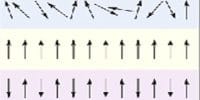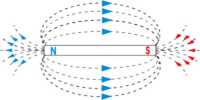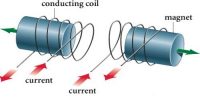Ferromagnetic substances are those in which each atom or molecule has a strong spontaneous net magnetic moment. These substances exhibit strong paramagnetic properties.
- The susceptibility and relative permeability are very large. (For example: μr for iron = 200,000)
- Susceptibility is inversely proportional to the absolute temperature. (i.e) X α 1/T. As the temperature increases the value of susceptibility decreases. At a particular temperature, ferromagnetic become paramagnetic. This transition temperature is called Curie temperature. For example, Curie temperature of iron is about 1000 K.
- When suspended freely in the uniform magnetic field, they set themselves parallel to the direction of magnetic field.
- When placed in a non-uniform magnetic field, they have a tendency to move from the weaker part to the stronger part of the field. They get strongly magnetized in the direction of the field.
Examples: Fe, Ni, Co and a number of their alloys.















